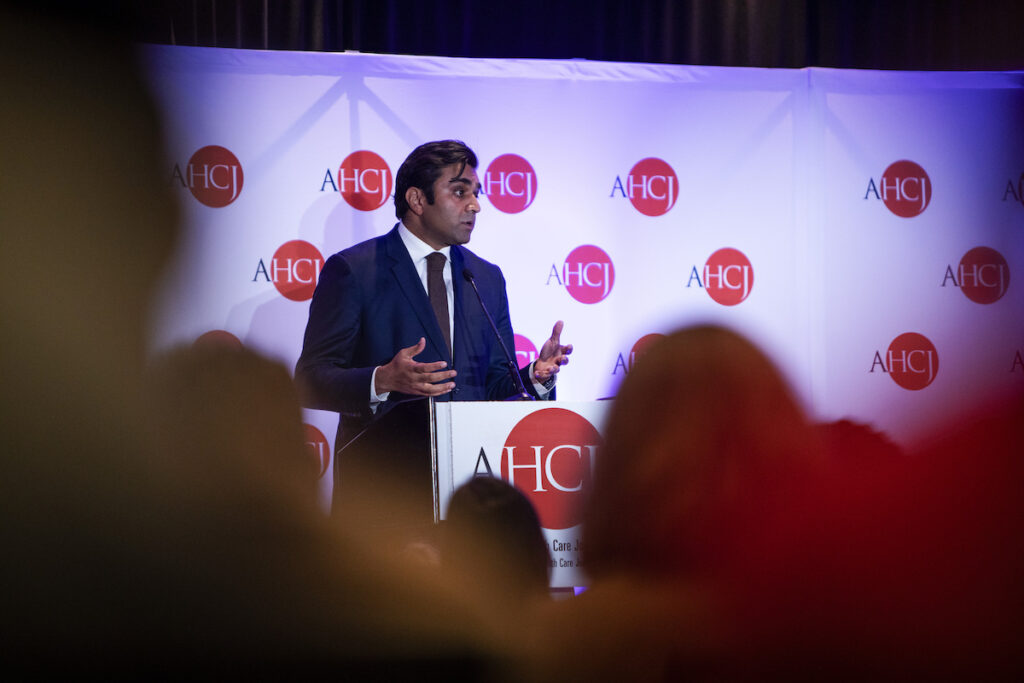New York State Health Commissioner Ashwin Vasan, MD, speaks at the plenary session of HJ24. Photo by Zachary Linhares
Public trust in the U.S. public health infrastructure has declined significantly because of how officials and agencies managed the response to the pandemic. The decline in trust in public health and science itself is evident in the country's growing political polarization, public health officials who have left their jobs due to threats and harassment during the pandemic, and the growing power and influence of anti-vaccination and other science-denial movements.
But public health cannot succeed without public trust. So how do policymakers and public health practitioners reinspire trust in public health institutions? And how do they do it after the largest exodus of public health leaders in American history?
The rise and fall of public trust
“They say trust goes down the elevator and goes up the stairs,” Ashwin Vasan, M.D., commissioner of New York City's Department of Health and Mental Hygiene, told attendees of AHCJ's Health Journalism 2024 keynote speech on Friday afternoon. “It takes a lot longer to build trust than it takes to lose it, and we are in a historic moment of distrust.”
Vasan's sentiments were echoed by Mandy Cohen, MD, MPH, director of the CDC and administrator of the Agency for Toxic Substances and Disease Registry, and were also echoed by what Brandi Zadrozny, a senior reporter at NBC News who moderated the discussion, has found through her reporting since the pandemic began.
 CDC Director Mandy Cohen, MD, MPH, addresses attendees during the plenary session of HJ24. (Photo by Zachary Linhares)
CDC Director Mandy Cohen, MD, MPH, addresses attendees during the plenary session of HJ24. (Photo by Zachary Linhares)
But both Vasan and Cohen shared their vision for how we can begin to rebuild that foundation of trust to better manage and improve public health during non-public emergencies in preparation for future pandemics.
“It starts with improving our data,” Vasan says. “COVID-19 showed us that our data was too siloed and fragmented to enable coordinated action with the speed and effectiveness that New Yorkers and Americans expect from public health. Our technology and systems were not up to par, so we've been working hard to fix that and make our data as open and transparent as possible.”
This priority led to the creation of the Population Health Data Science Center last year, with the goal of improving citywide population health surveillance for both reportable and non-reportable conditions.
Cohen similarly stressed that “first and foremost” data is essential to responding effectively to disease threats.
“You can't solve a problem you can't see, so you need to have a data foundation that allows you to spot threats early and respond quickly,” she said. “Secondly, you need the lab capacity to understand what's going on and be able to diagnose quickly. Third, you need talented people.”
The need for transparency
 Photo by Zachary Linhares
Photo by Zachary Linhares
But even with the best data, research capabilities and talented people, an effective response cannot be delivered without clear, transparent and ongoing communication to the public. Cohen acknowledged the role of journalists in the bigger picture.
“Every day I learn how important our news organizations, our journalists are,” said Cohen, who is leading North Carolina's COVID-19 response. [for] “Communicating important information to the public so they can protect their health,” she said, through both explaining technical information and telling stories in interesting and compelling ways that reach people's hearts and minds.
When Zadrozny asked Cohen how he thought the national response should be different in future pandemics, he responded, “Communicate faster and more frequently with a unified communicator, and put more of an operational focus on letting people know when and what tests, treatments, and vaccines they should get.”
They say trust goes down the elevator and goes up the stairs. It takes much longer to build trust than it takes to lose it, and we are in a historic era of distrust.
New York City Health Commissioner Ashwin Vasan, M.D.
A key part of an effective communications strategy in today's climate must also address the relentless, daily tsunami of misinformation and disinformation that pollutes radio and online platforms. Zadrozny asked Cohen and Vasan if they felt like they “knew the enemy” in combating the massive amount of misinformation and disinformation about public health. Cohen responded by listing three key strategies he believes are essential to fighting what Zadrozny semi-sarcastically called the “information war.”
“Those of us in public health need to communicate succinctly and quickly to keep up with the timeline of a rapidly changing news cycle, but at the same time, our communications need to have an element of repetition,” Cohen said. “We need more information.”
She can’t guarantee there won’t be any misinformation, but she can “get the word out there as useful as possible.” The other two strategies involve using trusted partners in the community to communicate that information in an engaging way.
“Investments in communications need to be at the heart of what we do, not an afterthought,” Vasan added. “Our information ecosystem is not only much more vast in volume, it's also much more fragmented. So let's flood the zone. Let's go everywhere. There is frankly no platform that we shouldn't be on.”



